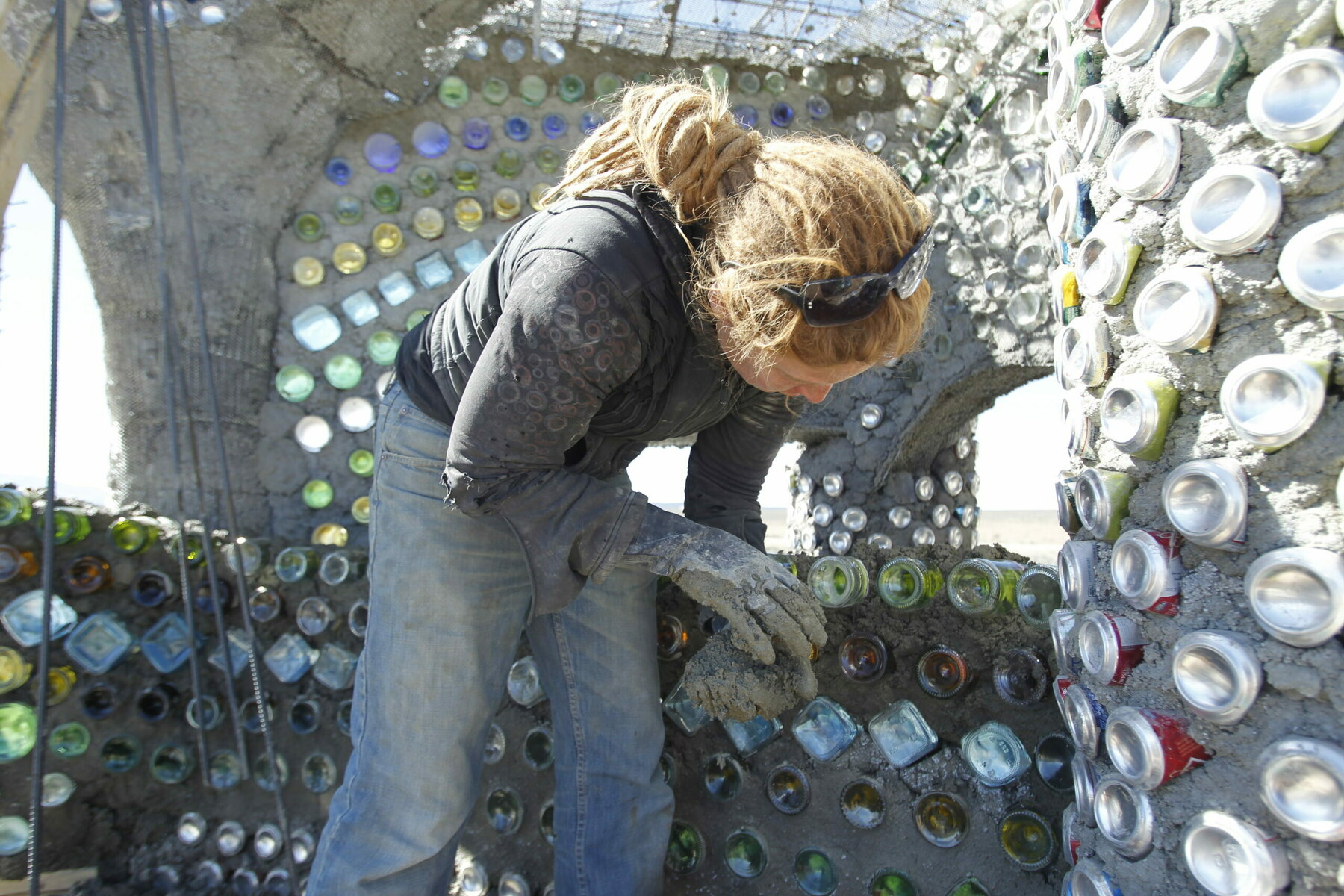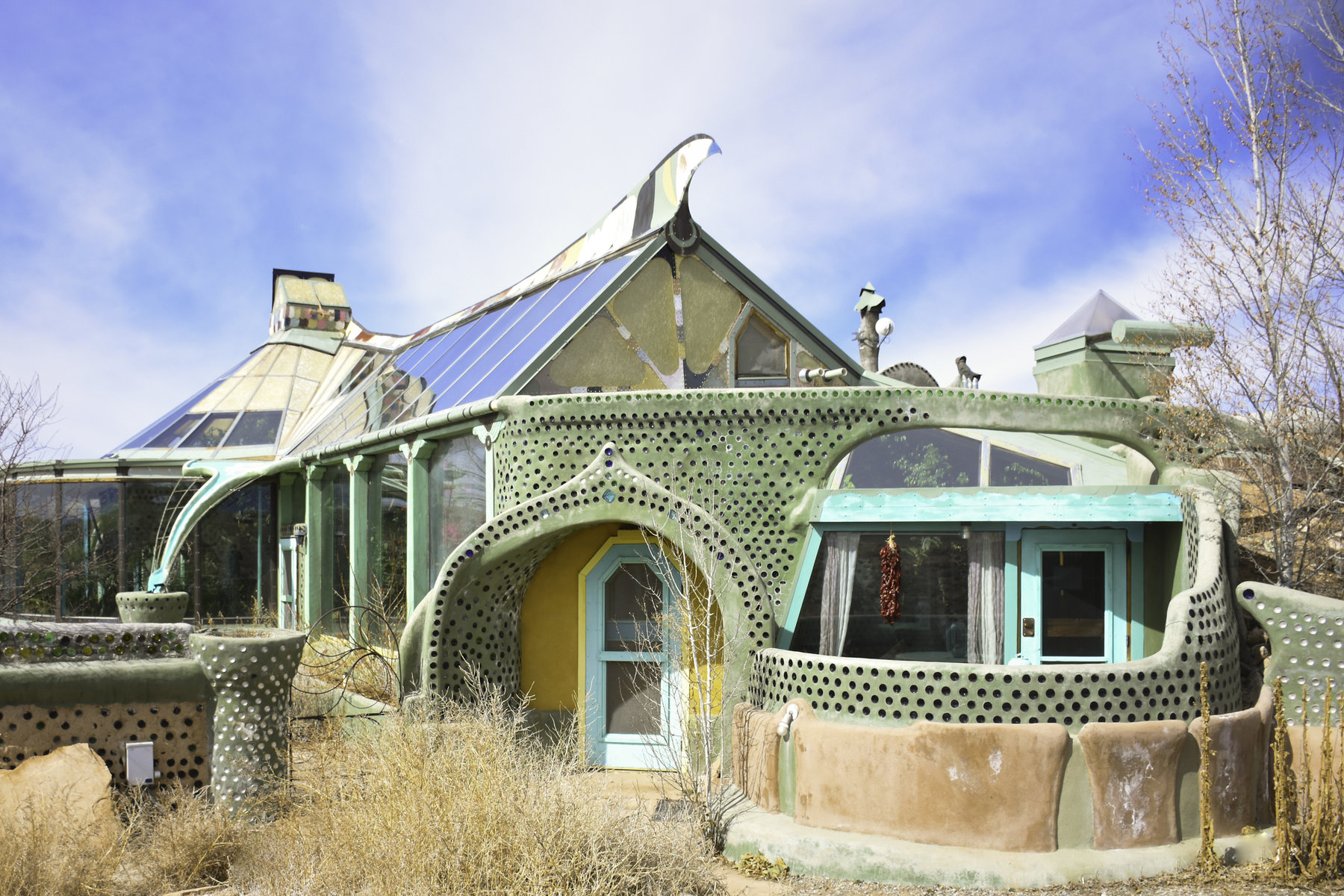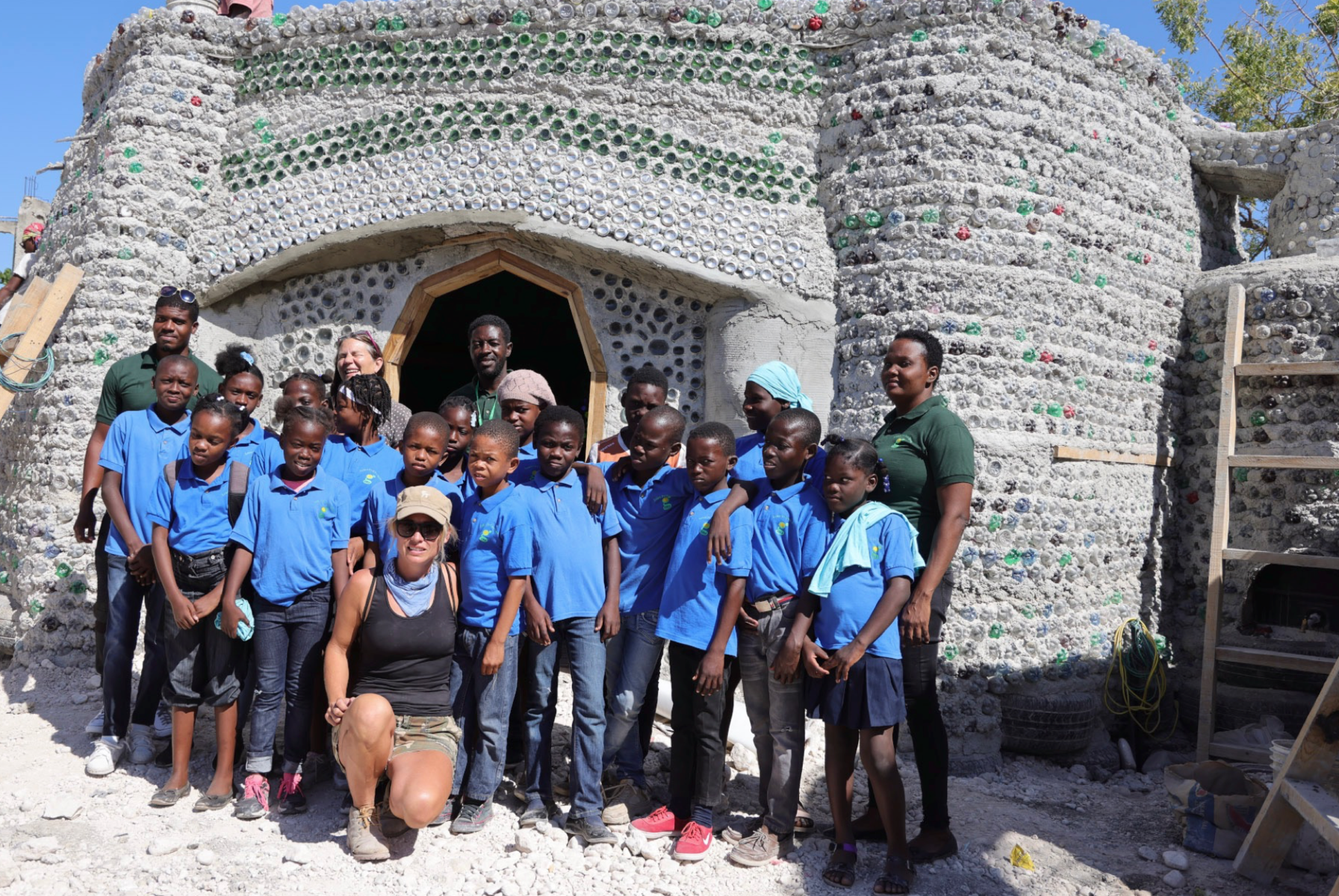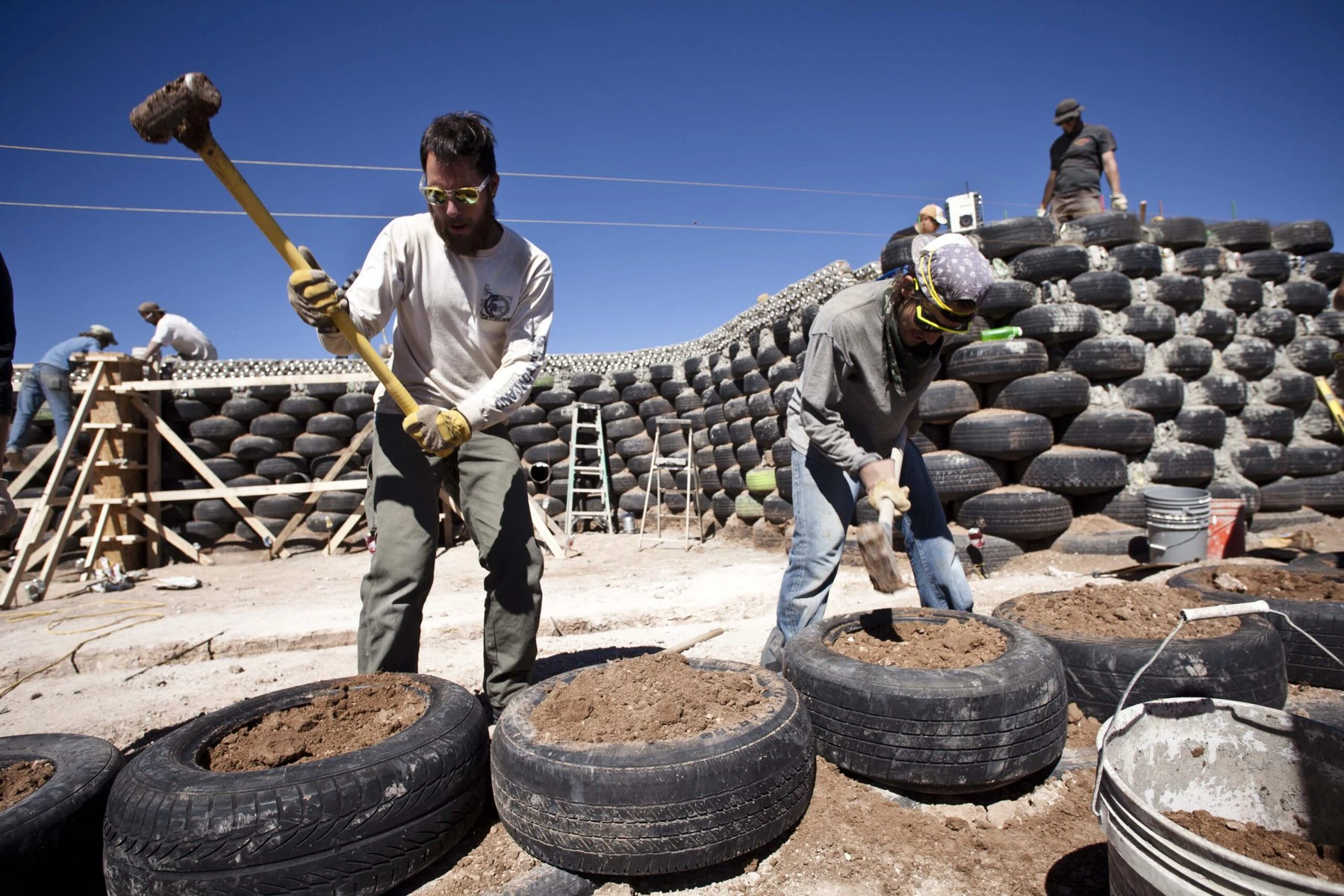Once you’ve crossed the massive steel bridge over the Rio Grande northwest of Taos in New Mexico, earth-colored domes arch out of the prairie. Did giant moles burrow fancy dungeons into the vast plains and decorate the mounds with green and red turrets for fun?
”You could think aliens landed,” even the founder of the housing settlement, Michael Reynolds, admits. “I guess that’s my responsibility.”
The 77-year-old architect and founder of Biotecture Enterprise has been experimenting here for more than 50 years with constructing earthships, self-sufficient off-grid houses that harvest their own electricity, water and heat.
The floor-to-ceiling windows in the earthship where we meet all face south to catch the sun’s heat, which warms the 1,800-square-foot house for free. When you enter the house through one of the artfully crafted massive wood doors, an earthy smell and tropical air linger — behind the windows grow banana and fig trees, tomatoes, kale, potatoes and roses. The greenhouse serves as a humid, warm buffer zone between the living area and the cold desert outside. “We build according to six principles,” Reynolds sums up his philosophy. “Passive thermal heating and cooling, power from the sun and wind, contained sewage treatment, building with recycled and natural materials, harvesting rainwater, and growing your own food.” These principles also explain why the architect with the gray tousle-head calls them earthships: Just like on a ship, the inhabitants have almost everything they need, independent of their surroundings.
State-of-the-art solar panels provide power and hot water. Rain is collected on the green metal roof, and the water is reused four times — first for drinking and showers, then to water the greenhouse, then to flush the toilets, and lastly, the gray water nourishes the Russian olive tree and shrubs in the garden outside. Though rains in Taos usually stay far under two inches per month, the collected water suffices for a thrifty family of four. Utility cost: zero. Depending on their diet, a family could grow most of their food in the greenhouse. “Initially, we had tilapia here,” Earthship Academy Director Lauren Anderson says, pointing to the fat orange koi in the indoor pond. “But they grew faster than we could eat them.” The chickens have their own miniature earthship in the courtyard.
Long dismissed as hippie havens, earthships have made a surprising comeback in recent years as a real solution for many construction problems. As gas prices rise, hurricanes leave entire states without power for weeks, and the climate crisis raises awareness of precious clean drinking water and other resources, the earthships are taking off. “I’m no damned hippie,” Reynolds states, “but the way society is going, I feel like I’m in a herd of buffalo heading for a cliff. I’m not going down that way. I’m trying to save my ass, and that is a powerful force.”
Indeed, earthships attract an increasing number of followers. More than 200,000 visitors check out the prototypes in Taos every year. The vehicles parked out front are no longer rusty pickup trucks but new Teslas. The pandemic and the climate crisis have spurred interest in sustainable, off-grid homes. Nearly 200 students learn about Reynolds’ principles every year at the Earthship Academy in a month-long course, and the earthships that are rented out nightly to tourists are almost always fully booked. And in an economy where supply chain issues rendered conventional construction materials expensive and scarce, the raw material for earthships can be found in abundance: trash.

Reynolds trudges ahead to show his latest construction site. Rows of stacked old tires, filled with sand and packed in concrete, insulate the U-formed shell to the north. Squashed beer cans protrude from half-finished adobe walls. Hundreds of blue, green, brown and clear glass bottles, floating horizontally in the walls, artfully filter the light.
The material is dirt cheap, but the construction is labor intensive. For many hours, a young crew of 12 pounds sand into the tires that are stacked to form a wall and then covered in cement. More than a thousand tires are upcycled in the back wall of a two-bedroom house. Reynolds recycles up to 20 tons of trash in every earthship. Taos county offers no recycling services, and when one young mason has finished her canned tea, she simply throws the container on the ground — it will be integrated into the wall she’s building.
With its preference for cement and steel, the construction industry is one of the biggest climate sinners and responsible for 38 percent of the world’s CO2 emissions, according to the UN. Increasingly, architects turn to upcycling to lower the carbon footprint of new buildings. “I see a surprising trend to low-tech solutions for sustainability, and earthships are part of that,” says New York architect David Benjamin who specializes in sustainable construction and leads the innovation lab at Columbia University. In Berlin, Germany, architects are building a so-called “Circular House” reusing doors, windows and granite from demolished buildings. For a pilot project in Esch, Luxembourg, designers create buildings from shipping containers, cans, bottles and compostable natural fibers. The architects of an addition to the design museum in Gent, Belgium, worked with sustainable bricks that scientists developed from local trash to achieve two goals at once: recycling and fewer CO2 emissions. And the Dutch designer Joost Bakker proved that off-grid living is even possible in the midst of Melbourne, Australia, when he built a three-story off-grid house with a greenhouse and sewage treatment in the city.

“The house takes care of me, and I take care of the house,” 34-year-old Texan solar engineer Gaelan Kefauver says while smoothing out an adobe wall in a half-finished earthship. He quit his job after working for well-known solar companies such as Tesla. “These companies say they want the best for the planet, but at the end of the day, it’s all about the bottom line,” he says and shakes his head. For the last three and a half years, he’s been helping Reynolds build earthships, and he also bought a cheap lot nearby to build his own. “This here is more genuine, more authentic,” he says. He likes that earthship living is “very simple.” Most earthships don’t have a TV or a dishwasher. “I might have to wait for a sunny day before I turn on the washing machine,” one of the earthship owners says, “but that I have to be mindful how I use resources is exactly what I like about it.”
Not all earthships are that simple anymore, though. The price tags have gone up. Phoenix, the fanciest earthship, is currently for sale for $1.5 million. It sports artfully rounded walls with handmade metal ornaments, a koi pond, and a fireplace with a built-in waterfall. A millionaire couple nearby built themselves a luxury ship with a solar-powered sauna, jacuzzi and dishwasher. To power such amenities, they invested in larger solar panels and water cisterns big enough to fulfill these needs and wants. Maybe because these luxuries contradict the original idea of simplicity, Reynolds rants, “I’m tired of building for rich assholes.”
Both with his building company Biotecture and his nonprofit Biotecture Planet Earth, Reynolds has built earthships in over 50 countries on five continents, as far away as Australia and Africa. After the tsunami in 2004, he and his team traveled to Asia to build emergency shelters on the Andaman Islands; similarly in Mexico after Hurricane Rita in 2006, in Nepal after the devastating earthquake in 2015, and repeatedly after disasters in Haiti, Puerto Rico, the Philippines, Malawi and numerous other countries.
“These countries are overflowing with construction materials — tires, glass bottles, cans — and people welcome us with open arms,” Reynolds says. “In Haiti, children collected tons of plastic and glass bottles that we used as insulation in the walls.” While Biotecture construction manager Deborah Binder struggles with bureaucracy and building codes in the US and Europe, the approval process on the Fiji islands “simply consisted of a four-hour Kava ceremony every time we moved earth,” 38-year-old Binder says with a laugh, “and we moved a lot of dirt.”
Even at home in the US, Reynolds and his 44 employees watched with concern as Americans were left without power and heat after the winter storm in Texas in 2021, and after hurricanes repeatedly destroyed the infrastructure in Puerto Rico. The five earthships they built in Puerto Rico are still intact, Reynolds says, and reliably provide energy with their solar panels and clean drinking water with their rain catchers.

Reynolds has improved the earthship concept over the decades. He readily admits that he initially made “a lot of mistakes.” There was the two-story earthship he sold to a writer until the sun was burning so strongly through the south-facing window front that it melted the plastic casing of his typewriter. Another mistake was the yoga center where the yoga instructor insisted on east-facing windows instead of south to catch the panoramic view over the Sangre de Cristo mountains. In winter, the freezing guests now huddle around the retroactively installed wood-burning stoves. Several lawsuits brought by aggrieved earthship buyers in the 1970s due to leaking roofs and freezing living rooms ruined Reynolds’ reputation.
He even lost his architectural license for 17 years. Only when the architectural registration board noted that he and his crew built earthships for free after disasters in Haiti, Puerto Rico and other countries, did he get his license back in 2007. “I’m a Trojan horse,” the maverick comments triumphantly, “that creeps through their assholes and changes the system from the inside through their bloodstream.”
Weighed down by negative news?
Our smart, bright, weekly newsletter is the uplift you’ve been looking for.In 1972, he built his first trash house, nicknamed “The Thumb” because it juts out of the mesa like one, simply from beer cans and concrete not far from the current Taos development site. The subsequent fight to build his unconventional climate-friendly buildings with official permits cost Reynolds the better part of two decades. “You can throw nuclear bombs into the New Mexican desert,” the renegade rants, “but not build earthships!” He even drafted a law, cut his long gray hair, put on a suit and knocked on the doors of senators until New Mexico approved a law in 2007 that allows Reynolds to construct sustainable buildings “for testing purposes.” One of his longest-serving foremen, 52-year-old Phil Baseheart — who had also struggled with the architecture profession until he arrived in Taos at 22 years old — reveals with a wink that his crew complies with all official inspections, but admits that sometimes an earthship might be declared a “greenhouse” to get the necessary permits, and if the owner then lives in it, that’s up to him, eh?
The thick walls in the modern earthships indeed hold the temperature comfortable even as an icy wind howls outside. If a resident likes it cooler, they can open the cooling vents on the north side. The recent models are equipped with a washing machine and a bathtub, like the one bought by Julie Bergman, a renowned filmmaker from Los Angeles. In the summer of 2022, she purchased a new earthship in Reynolds’ development for $600,000 on one acre of land, with two bedrooms and two bathrooms. When she travels, she rents it out for $300 a night. “This is the best legacy I can leave my daughter Brooke,” Bergman states, “a possibility to live sustainably and consciously.” The untreated stone floors are from a nearby rock failure, the aspen for the massive beams from nearby woods. Reynolds deconstructed a mighty old ranch gate for the ceiling, and local carpenters made most of the furniture from massive wood. “When you come here, you immediately feel grounded,” Bergman says. “Nothing blinks and vibrates. I sleep better than anywhere else.”
When Bergman first visited friends in the area 15 years ago, she found the earthships “creepy, like Mad Max.” But after repeated visits, she changed her mind. “I think more and more people will realize that this here is the future. How wasteful construction is in Los Angeles disgusts me.”
Other earthship owners voice similar motivations. Christian Drake, a successful artist, found the earthships through Google. “Up to 20 tons of trash are in every house,” he says proudly. “Which other house does that?” He simply transferred his bougainvillea and plumerias from his former home in Laguna, California, into the indoor greenhouse. Another owner, California designer Andy Bratz, researched other passive solar houses before deciding on an earthship. The deciding factor for him: “They are undeniably more sustainable when you look at the materials.” But because California building codes wouldn’t allow for tire walls, he will move to Taos when his earthship is built.
People can buy a turnkey earthship like Bergman and Drake, or download one of the construction plans for about $1,000 from the Biotecture website like Bratz and escape the credit crunch by building it themselves for as little as $20,000. The term earthship is trademarked, though. “A few years ago, we got a call from someone in Portugal because a tire wall had crumbled and buried two people under it,” Binder says. “Turns out we didn’t have anything to do with the construction and the wall wasn’t built to our standards. Since then, we have protected the name.” Still, young architects like Nizar Haddad in Lebanon copy elements such as the tire walls and south-facing windows to build their own earthship-inspired passive houses — Haddad calls his “Lifehouse.”
Reynolds owns most of the land in the 630-acre development near Taos. But he didn’t get rich, he says. He drives a banged-up gray pickup truck (and a 1976 Mercedes with velvet seats), and his down jacket is held together with duct tape at the elbows. The rebellious architect grew up in a Baptist family in Louisville, Kentucky, with a dad who collected anything that could possibly be reused — some might call him a hoarder. “No music, no dancing, no sex,” Reynolds remembers about his youth. After studying architecture in Cincinnati, Reynolds traveled to New Mexico for motocross racing to avoid being drafted to Vietnam. “I raced like the devil,” he says. “Everybody else tried not to get hurt but I wanted to get hurt so I couldn’t go to Vietnam.” He successfully crashed and stayed.

Two years ago, he was diagnosed with prostate cancer, stage 4. “The doctors told me to choose a coffin,” he says with a wry laugh, “but I decided not to listen to them. I changed my diet, mostly eat the vegetables I grow myself and I don’t eat meat anymore.” Almost every morning, you’ll find him at a construction site, hauling beams and barking orders. “Look at me, I feel fabulous!” he says.
But he does have a plan to spread the earthship gospel more widely before time might run out for him. Most recently, he constructed the barebone earthship model “Refuge.” Though constructed according to the six earthship principles, it features just one row of windows in standard sizes, cheaper wood beams, and it lacks the creative décor of the more extravagant models. The Refuge could be built within a few months almost anywhere in the world. “This is how we’ll solve the housing crisis,” Reynolds hopes, beaming. “I’ll build it all over the world.”
Then he puts his duct-taped coat back on. He has to run, to the next construction site. He has no time to lose.



